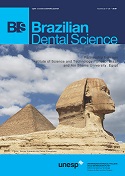Microorganisms related to early childhood caries in a sample of an oral preventive-educative program: a longitudinal study
DOI:
https://doi.org/10.14295/bds.2019.v22i2.1723Resumen
Objetivo: Premature acquisition of cariogenic microorganisms seems to be related to higher prevalence and activity of caries lesions. The aim of the study was to evaluate the prevalence of Streptococcus mutans and Streptococcus sobrinus in infants enrolled in a dental preventive program and in their mothers, as well as to assess the influence of bacterial prevalence, diet and oral hygiene in dental caries prevalence. Material and Methods: After clinical examinations (n = 50), saliva and oral biofilms were collected and stored prior to real-time PCR at 6, 12, 18 and 24 months of age. Results: No correlation was observed between the presence of cariogenic pathogens and diet or hygiene habits at all ages; however, association increased with number of erupted teeth. Salivary levels of bacteria were lower in children than in their mothers at all ages, and children with carious lesions had high ingestion of sugared food. Conclusion: As the levels of cariogenic pathogens were low in the patients that were enrolled in a preventive program, we can conclude that control of oral biofilm as eruption of infants’ teeth occurs and sugar ingestion should be considered of great importance in preventive dentistry, because the association between them was highly positive.
Keywords
Saliva; Dental caries; Oral hygiene; Cariogenic; Streptococcus mutans.
Descargas
Descargas
Archivos adicionales
Publicado
Cómo citar
Número
Sección
Licencia
Brazilian Dental Science uses the Creative Commons (CC-BY 4.0) license, thus preserving the integrity of articles in an open access environment. The journal allows the author to retain publishing rights without restrictions.
=================
COPYRIGHT TRANSFER AND RESPONSIBILITY STATEMENT
(PDF)
For all articles published in the BDS journal, copyright is retained by the authors. Articles are licensed under an open-access Creative Commons CC BY 4.0 license, meaning that anyone may download and read the paper for free. In addition, the article may be reused and quoted, provided that the original published version is cited. These conditions allow for maximum use and exposure of the work while ensuring that the authors receive proper credit. All metadata associated with published articles is released under the Creative Commons CC0 Universal Public Domain Dedication.
Before the submission, authors must obtain permission to reproduce any published material (figures, schemes, tables, or any extract of a text) that does not fall into the public domain or for which they do not hold the copyright. Permission should be requested by the authors from the copyright holder (usually the Publisher, please refer to the imprint of the individual publications to identify the copyright holder).
The authors hereby attest that the study is original and does not present manipulated data, fraud, or plagiarism. All names listed made a significant scientific contribution to the study, are aware of the presented data, and agree with the final version of the manuscript. They assume complete responsibility for the ethical aspects of the study.
This text must be printed and signed by all authors. The scanned version should be submitted as supplemental file during the submission process.




























